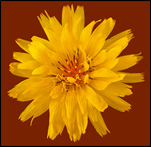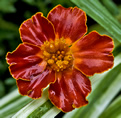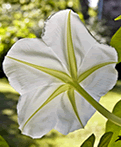
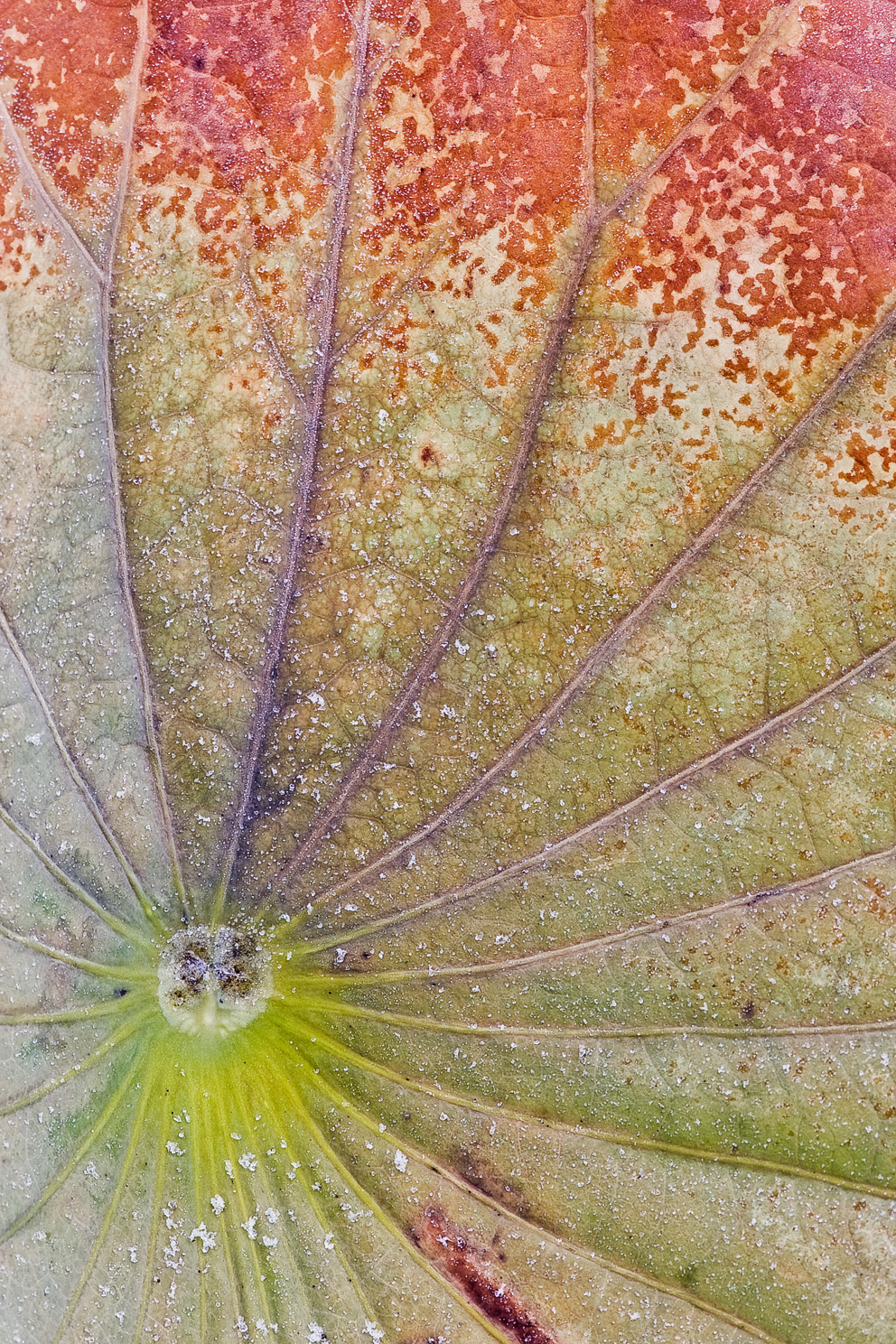
The Sacred Lotus ∞ Nelumbo nucifera
Amherst, Massachusetts
• 19 October 2013
Photograph by Stephen Gingold

Edgar Allen Poe
from Al Aaraaf | first published in 1829
By Stephen Gingold
Posted on 4 December 2013
I've visited the lotus pond in our town countless times over the years and, like many, have been drawn mostly to the rich, deep pink of the blooms as they open during the late summer months. Come October when the warm season ends, the leaves of the lotus fade quickly into a sere brown paper….
But, if you time it right….
There comes a special moment in the autumnal transition from life to death when the act of natural transformation of the lotus becomes infused with dramatic color and striking form.
When I choose a subject for a photograph, I am not seeking an allegory for life, nor a romantic experience, nor some deep meaning about our existence. Those emotions and insights do happen sometimes, but I try to leave the ephipany and philosophy for others as it is not my strength.
Instead, I simply respond to nature. My compositions in photography are based on my initial response. Sometimes, the moment of creation needs a bit of adjustment to simplify matters, as was the case with my lotus photograph. How much of the leaf should I show? To include the entire leaf would introduce background distractions, so I moved closer and placed the center of the leaf at a thirds position. The resulting composition draws the viewer's attention to the heart of the image.
I do wish to convey my response to the lotus in an artistic manner, but sharing a bit of natural history in an intimate fashion is my primary goal.
∞
Origins: Egypt to North AmericaLate in the nineteenth century, botanist E. D. Sturtevant (1842-1898) of Boston became the North American champion of the Sacred Lotus — and not for beauty but for bean! The value of the lotus as an edible plant prompted Dr. Sturtevant to cultivate the Sacred Lotus in aquatic plantations at his experimental “Waushakum Farm” in South Framingham, Massachusetts. Beans were a particular passion of the inventive botanist, who studied the history of legumes and sometimes wrote about them under the pen name “Zelco.” As you will see in the text from Garden and Forest that follows, ‘Egyptian Beans’ from the fruit of the lotus were a favorite treat amongst the folk of the ancient Nile, a historical fact that no doubt influenced Dr. Sturtevant’s decision to cultivate the plant at his farm.
We wonder on this night in 2013 if the lotus leaf photographed by Stephen Gingold for our web feature is a direct descendant of Waushakum Farm stock. Could be. Stephen's lotus lives not very far from the site of Waushakum Farm. Could be!
We do know that in the 1880s, the Massachusetts botanist oversaw the cultivation of a Sacred Lotus “plantation” in Bordentown, New Jersey, a showcase project featured in Garden and Forest,an influential journal of horticulture and landscape art. In light of today's native plant movement, spearheaded by Douglas W. Tallamy in his 2007 manifesto Bringing Nature Home, the implications of the Garden and Forest article are telling, if not profound.
“I believe that the day is not far distant when this so-called ‘Sacred Lotus’ and its beautiful varieties will be as universally cultivated and as popular in America as they now are in some eastern countries,” Dr. Sturtevant wrote in the April 10, 1889, issue. The editors of Garden and Forest enthusiastically agreed. Here is their report.

We have more than once alluded to the great service rendered to American horticulture by Mr. Sturtevant in popularizing the cultivation of the finest aquatic plants in this country. A still greater service is his demonstration of the fact that the beautiful “Sacred Lotus” can be naturalized here. Its hardiness having been demonstrated, there is now no reason why this Lotus cannot be made to cover shallow ponds from Cape Cod through all the coast-region of the middle and southern states; or why this beautiful plant may not become as conspicuous a feature in American life and art as it is in those of Japan, where, although doubtless introduced from continental Asia, it is as widely spread as any indigenous plant. If the Bordentown experiment proves to be the precursor of many thousand more, as it is sincerely to be hoped that it may, Mr. Sturtevant's name will deserve to live among those of men who have made valuable contributions to American civilization.
As far back as written history or the picture-records of ancient peoples reach, the “Sacred Lotus” may be found; and no other plant has played so prominent a part in the ceremonies of royal life, in the rites of religion, or in the development of art.
Many kinds of Water-lilies were familiar to the ancient Egyptians, and the name Lotus seems to have been given to them all. Among them were Nymphæas analogous to our common white and yellow Water lilies, and also a species with blue flowers (N. carulea or stellata), and another which was either red or white with red-streaked sepals (N. Lotus). But the true Egyptian Lotus, the "Sacred Lotus” of the whole East, is the plant with rosy flowers which Linnæus called Nymphera nelumbo, but modern botanists have placed in another genus and called Nelumbium speciosum. This no longer grows wild in the Nile, and, perhaps, was not a native of Egypt. It appears in very early pictures produced at a time when Egypt was practically shut off from the rest of the world; and if it was, indeed, an exotic, must have been introduced in those primitive days when this part of the world was being peopled, or re-peopled, by tribal immigrations from the East. But there is nothing improbable in such a supposition. Tree-worship was one of the very earliest forms of religion, and where trees were adored certain flowers may well have been held sacred and have been transported from place to place, together with such herbs and roots as had proved themselves possessed of healing properties. The Lotus seems to have been revered in India as well as in Egypt from the dawn of history; and it is not impossible that it traveled from the former country — where we know it is indigenous — to the banks of the Nile at a time so remote that even Egyptians of the earliest historic dynasties may have believed in its local origin.
….
The flower, which stands higher than the leaves, is borne upon a stalk which, instead of being soft and pliant like that of the Water-lily, has the firmness and consistency of wood. It has an agreeable smell like that of Anise. In the bas-reliefs the Egyptians are often seen holding it to their nostrils. The fruit, which is shaped like the rose of a watering-pot, contains seeds as large as the stone of an Olive. These seeds, which were eaten green or dried, were called ‘Egyptian Beans’ by the Greek and Latin writers ‘because they were consumed in such vast quantities in the Nile valley. Even the root was not wasted; according to the old historians it had a sweet and agreeable taste.
Herodotus compares the seeds of the Nymphaeas to those of the Poppy. They, too, were eaten, being pounded in a mortar and made into a kind of bread. But neither of these plants should be confounded with the Lotus which formed the food of the so-called Lolophagi, in Ethiopia, and has been so widely celebrated for its Lethe-like effects by ancient and modern poets. This was the “Lotus tree,” which Pliny says some persons identified with the Celtis, but which modern commentators believe to have been the Rhamnus Lotus of Linnaeus, the Zizyphus Lotus of more recent botanists.
The extensive thickets which the Lotus formed along the banks of the Nile are frequently pictured on Egyptian monuments, with men in boats hunting aquatic birds and animals among their crowded stems; and ancient writers tell us that popular festivals were held among these green and rosy water-groves. Constantly when sacred ceremonies are portrayed, Lotus-flowers are held in the hand of the chief figures. They were the symbols of generation, life, resurrection and immortality, and therefore consecrated to Osiris. The four genii of the future world are sometimes depicted standing upon them, and they likewise form a seat for the infant Horus, while historians tell us that they were appropriately presented to the guests at funerals.
In Assyrian and Persian sculptures the Lotus is almost as conspicuous, alternating with the Pine-cone as an accompaniment of the most solemn rites. In India, again, we find the same thing — constantly the Lotus occurs, and its sacred character is always apparent. Hindu legends say that Brahma came forth from its blossom, and Sri and other gods are sculptured sitting upon an open flower and holding buds in their hands. Buddha is likewise thus portrayed, and, according to some accounts, first appeared floating on this mystic flower.
Perhaps it was the spread of Buddhism which carried the Lotus to China and Japan. But from whatever place it came and at whatever time, it soon grew to be as familiar and beloved as it had been at home. At every step in Japan one finds great tanks filled with the Lotus, and in many religious ceremonials it has its function, while the peculiar grace of its habit and its beauty of form and color in leaf and bud and flower and fruit, added to its religious significance, have made it chief among the artist's models. Countless works of Japanese art are based, palpably or remotely, upon the Lotus, from the delicate lines of the surface-decoration applied to some tiny object or the pattern on a woven stuff, to the great bronze vase in which the living plants are grown.
∞
GARDEN AND FOREST
A Journal Of
Horticulture, Landscape Art and Forestry
∞
Conducted by Charles S. Sargent
Director of the Arnold Arboretum, Professor of Arboriculture in Harvard College, etc.
Volume II. January to December, 1889
New York | The Garden and Forest Publishing Co. | 1889
pp.173-174
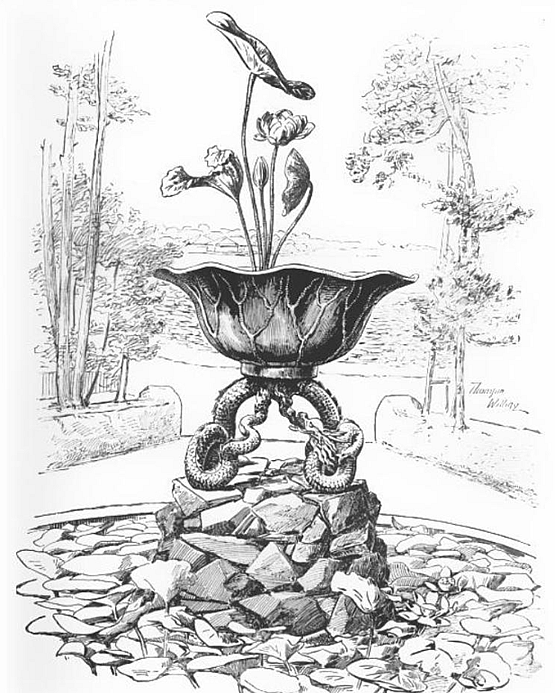
A Japanese Lotus Vase
Image digitized by Google from Garden and Forest, April 10, 1889
The Soul Drawn Out
The lotus is one of the most interesting of legendary plants, but there is a great deal of perplexity connected with its history, as there are many plants to which the name of lotus has been given, and it is very difficult to identify the sacred lotus, which if not actually worshipped by the Egyptians, received divine honours, as an emblem of life and growth, and of the sun springing from the ocean, also, on account of its luxuriance of the earth's fecundity. This plant, which is reported to have been most beautiful, is said to have sprung spontaneously from the watery expanse of the Nile, unfolding its leaves and gorgeous blossoms above the surface of the water. This is symbolized by the poets to mean “the soul drawn out of an evil nature, and surmounting the bounds of sense.” The leaves of this plant resist water, which “trickles from them as from a lion's mane;” so an Eastern proverb compares a man who resists temptation to a lotus leaf.
∞
HARDWICKE'S:
Science-Gossip for 1873:
An Illustrated Medium Of Interchange And Gossip
For Students And
LOVERS OF NATURE.
∞
Edited by J. E. Taylor, F.L.S., F.G.S., &c
London : Robert Hardwicke, 192, Piccadilly | 1874
p.152
∞
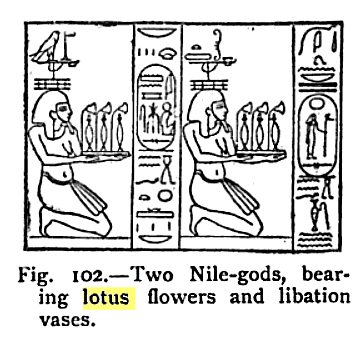
Nelumbo:
a Lotus by any other Name....
Taxonomy remains an elusive pursuit. Names of things change with scientific fashion. The careful reader of text on this web will have noticed the different names for the flower at hand. So, another:
The sacred Bean Lily of India, the Nymphea Nelumbo of Linnæus, is a splendid Indian water plant, most generally known in Europe under the name of Lotus. The natives of Hindostan, by whom it is most highly venerated, call it Támará; the people of Ceylon, Nelumbo. It has sometimes been confounded with the Lotus of Egypt, the Nymphea Lotus of Linnaeus. "This celebrated plant is found growing in still pools or shallow lakes near the margins of running streams. The leaves, which, when at full size, are two or three feet in diameter, of a beautiful green above, and purplish beneath, float, while young, on the surface of the water, above which they afterwards rise on prickly stalks, as do also the flowers, which (says Roxburgh) are large and beautiful beyond description, particularly in the rose-coloured variety. They are about nine or ten inches in diameter, and nearly inodorous. What chiefly distinguishes this plant is its peculiar mode of propagation. The capsule, or seed-vessel, greatly resembles a wasp’s nest, and, when the seed becomes ripe, this capsule separates from its stalk, and falls into the water with all the seeds in their respective cells, which, beginning to vegetate, present a cornucopia of young sprouting plants, which, after a time, loosen from their cells, and, falling down, take root in the mud.” —Classes and Orders of the Linnaean System Illustrated.
∞
Floral Fancies
And
Morals from Flowers.
∞
Anonymous
London : Tilt and Bogue, Fleet Street | MDCCCXLIII
pp 141-142
Fading Frosted Lotus was posted on Wednesday, December 4, 2013
Canon 40D, Canon 300f/4, f/11+2/3 exposure compensation,
1/5 sec, ISO 100, tripod mounted.
![]() Stephen Gingold Nature Photography
Stephen Gingold Nature Photography
Crow's Cottage is pleased to publish Stephen's second contribution to our collaborative web. Based in Amherst, Masachusetts, Stephen passionately ascribes to a natural history philisophy inspired by the wonders of diversity in nature and grounded in the complexities of ecology. His web includes galleries of waterfalls and streams, butterflies and moths, flora and fauna, and the landscapes of woods, meadow, and water. It's a visual treat of original beauty.
![]() Stephen Gingold Nature Photography Blog
Stephen Gingold Nature Photography Blog
Featuring commentary related to images of nature from western New England, Stephen's WordPress blog, launched in May 2010, combines backcountry travel logs, photo tips, and natural history into a very good read. Our industrious colleague works diligently to keep the blog current.
![]() Mysteries of Perception
Mysteries of Perception
Stephen's photograph of the Meadow Beauty, Rhexia virginica, illustrates a Crow's Cotage essay, "Thoreau's Cream Pitcher Is My Meadow Beauty."





